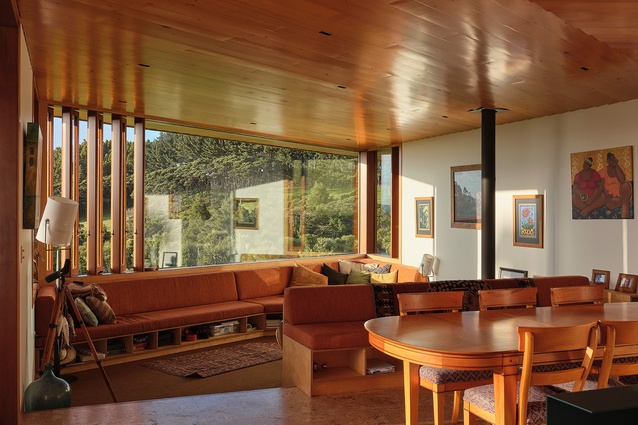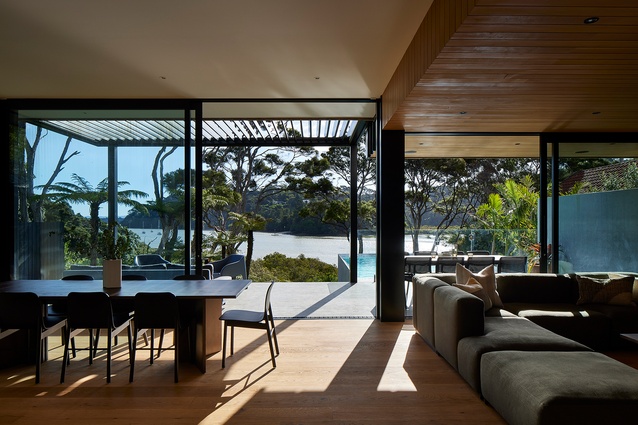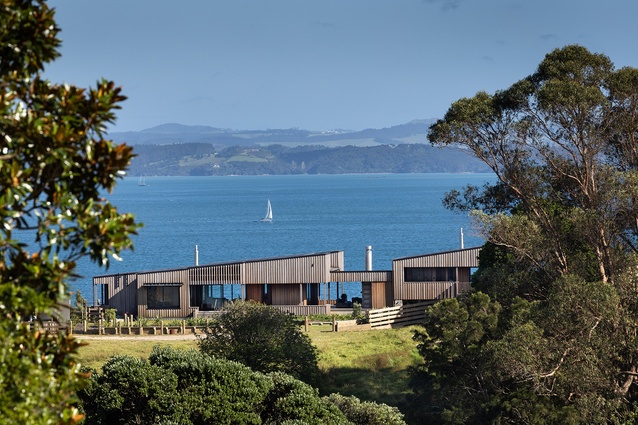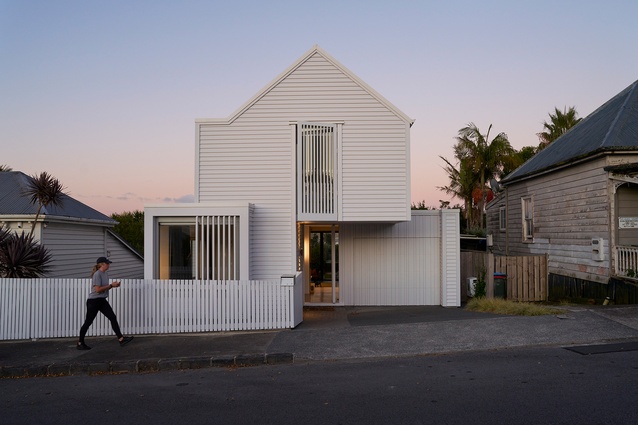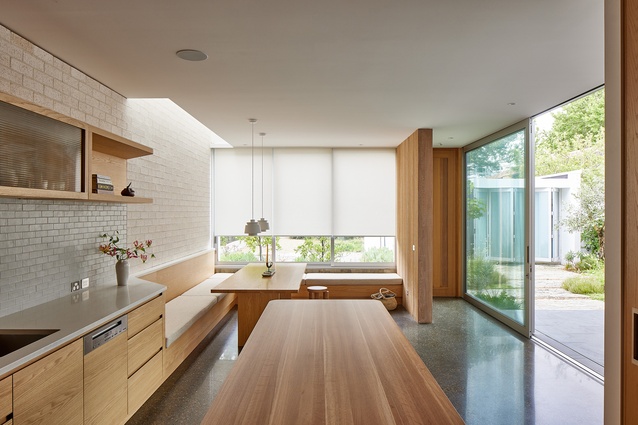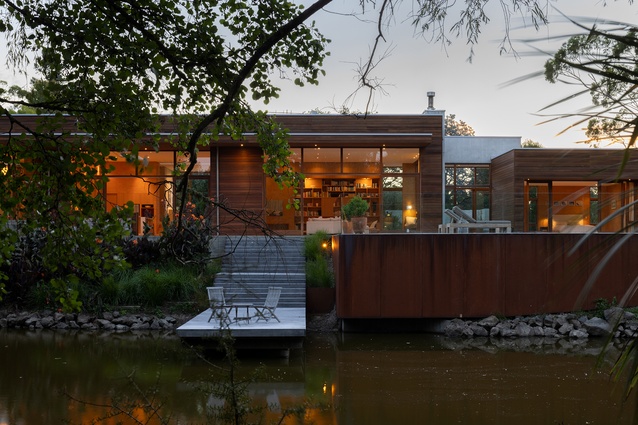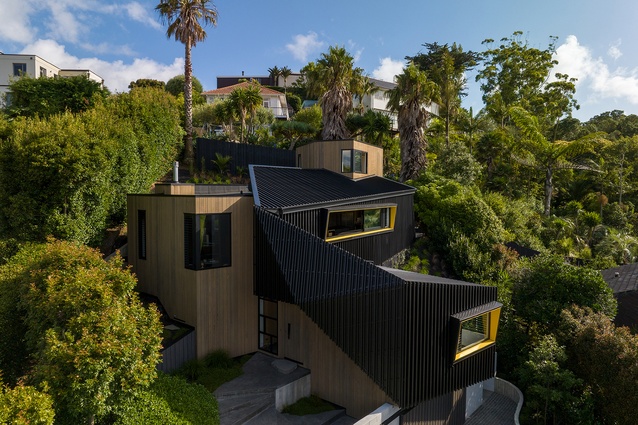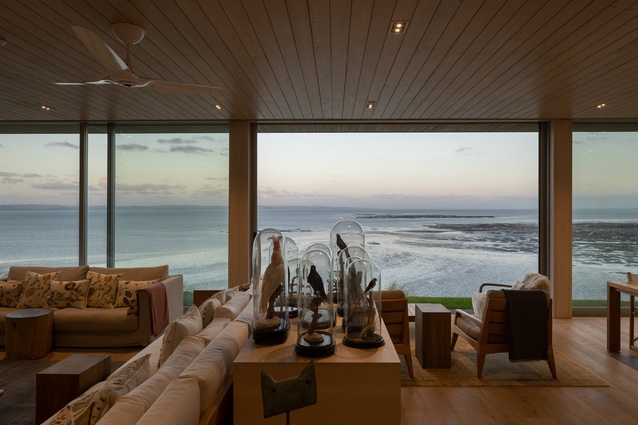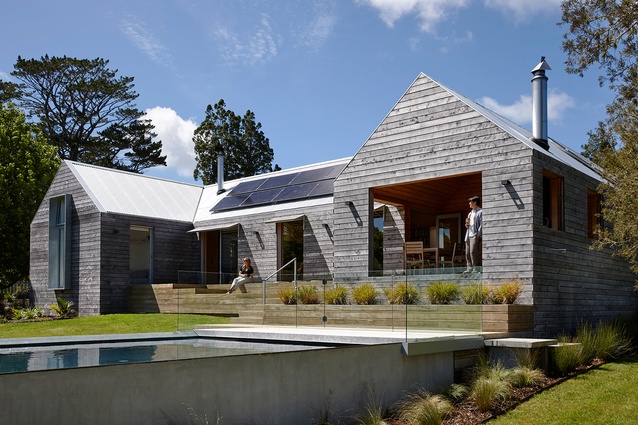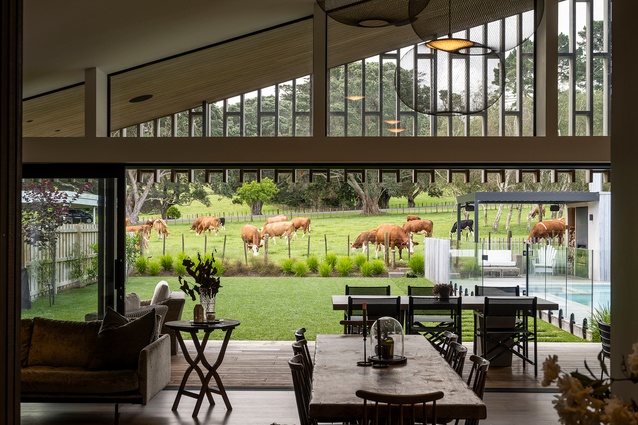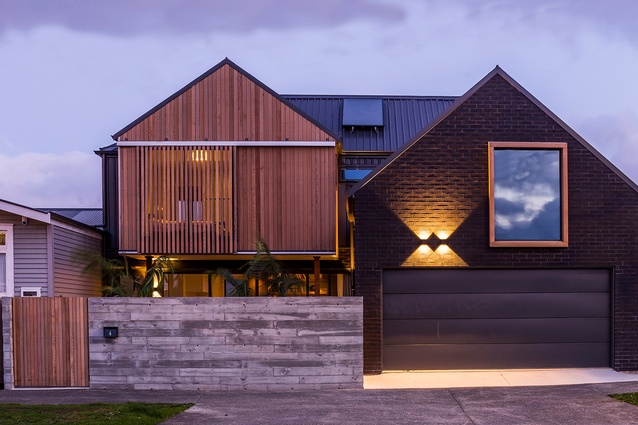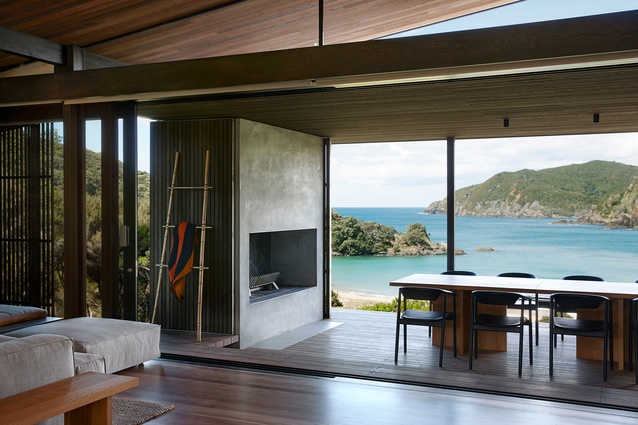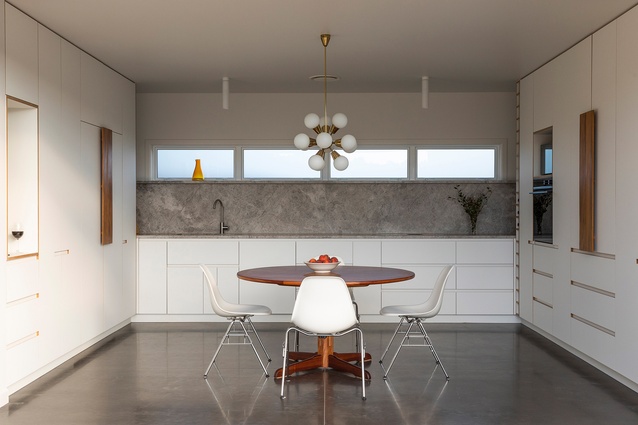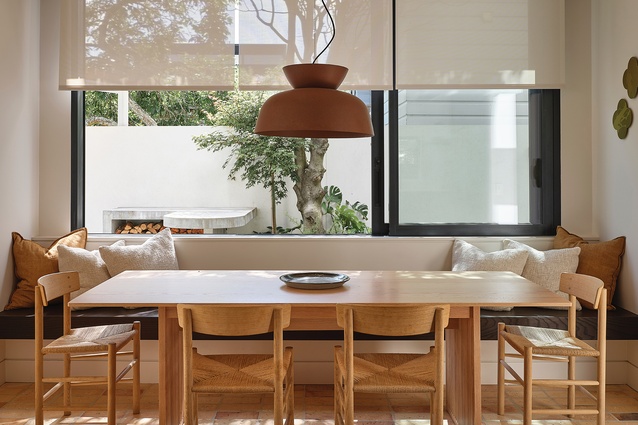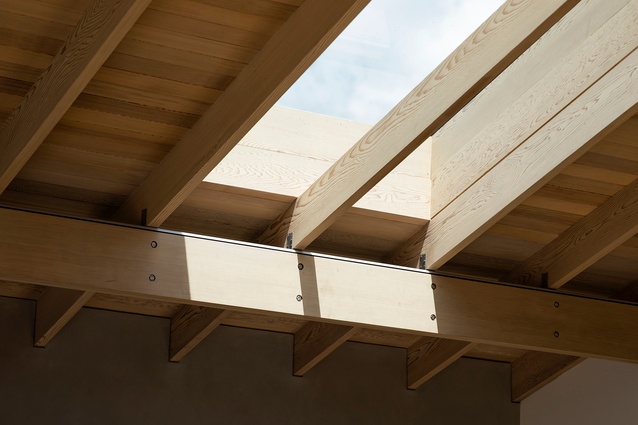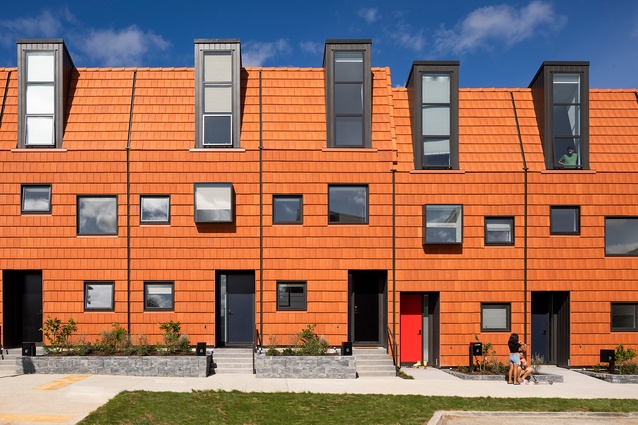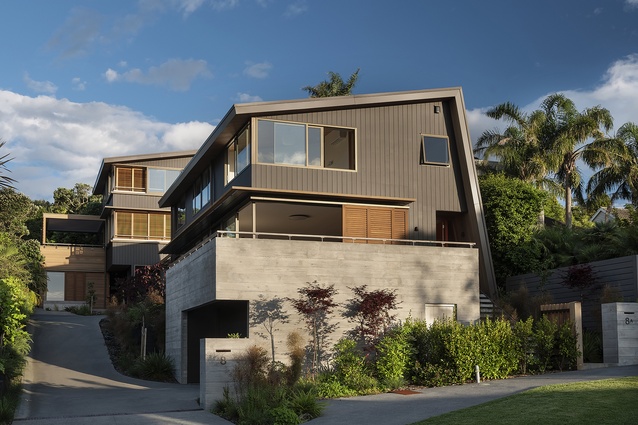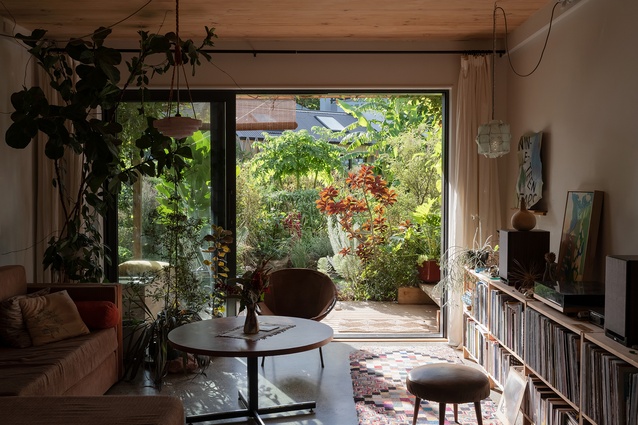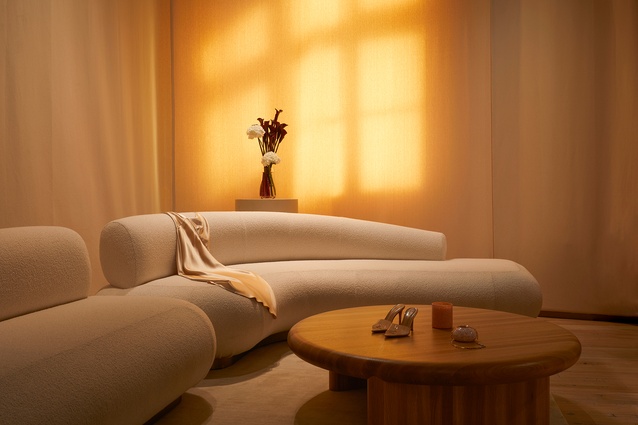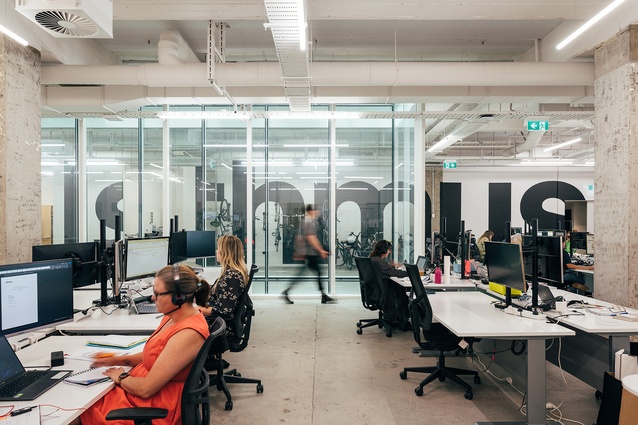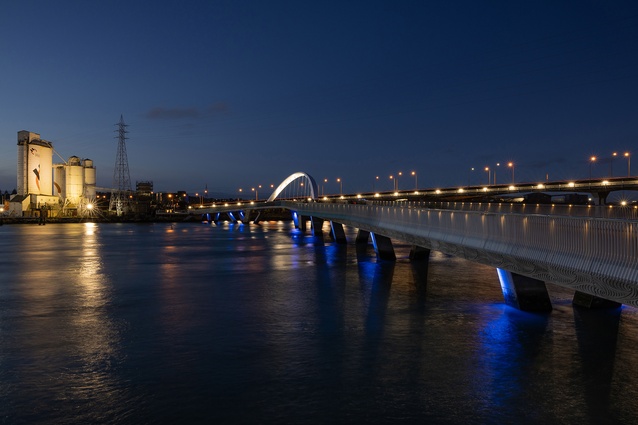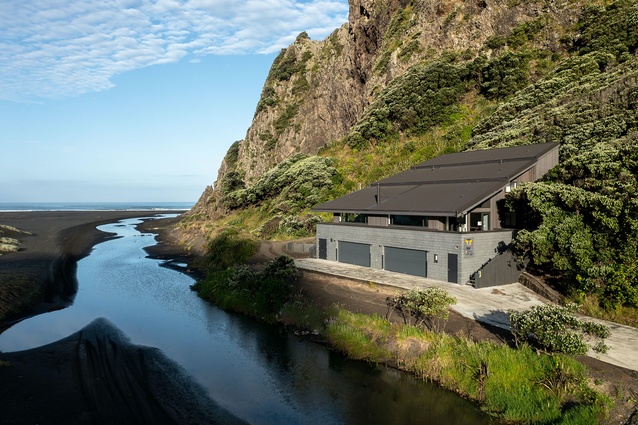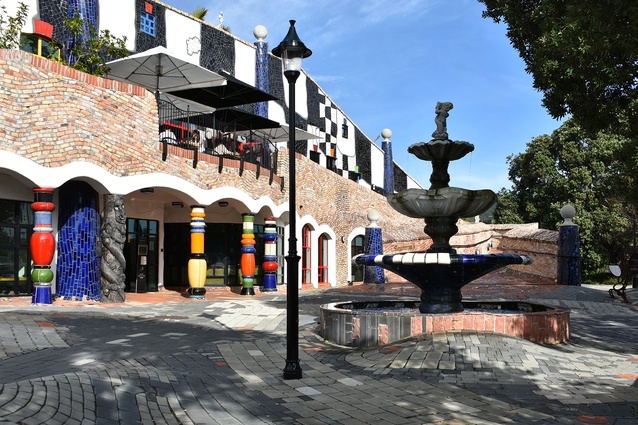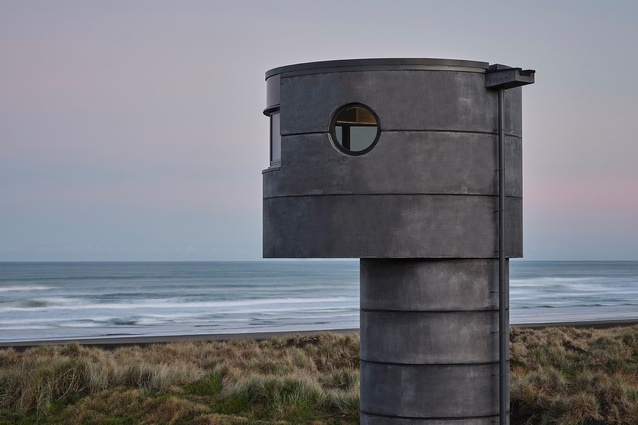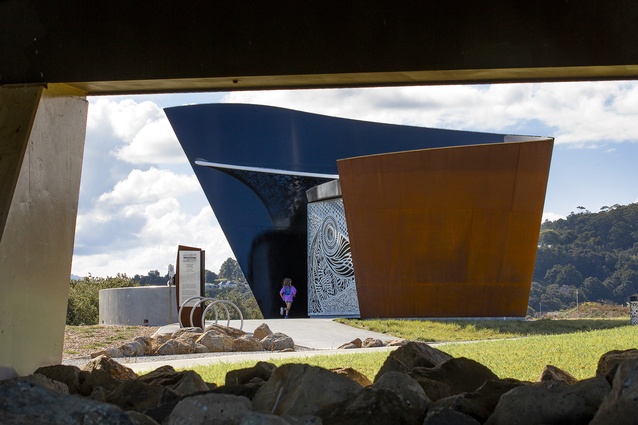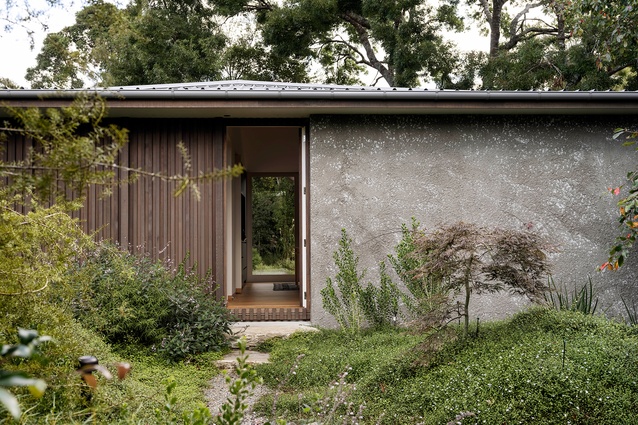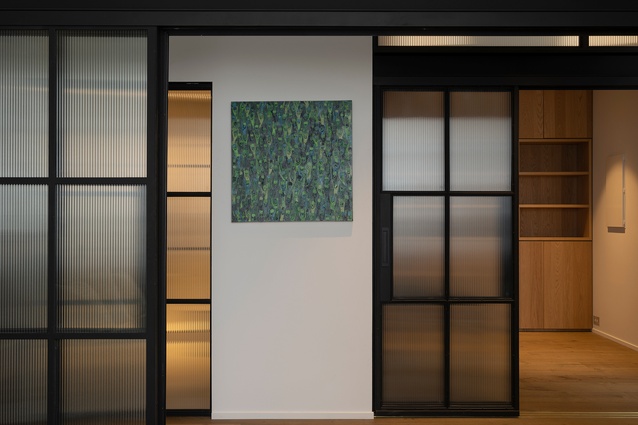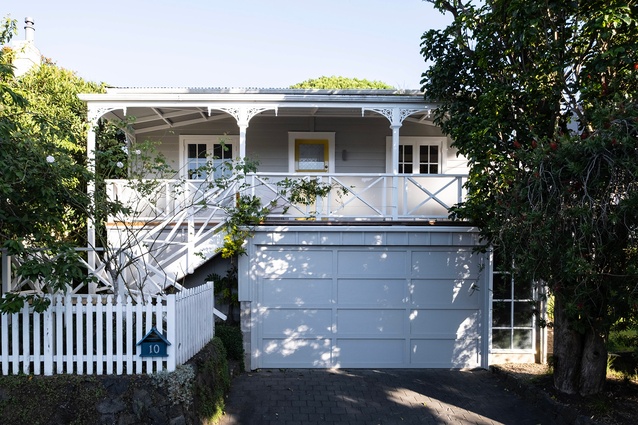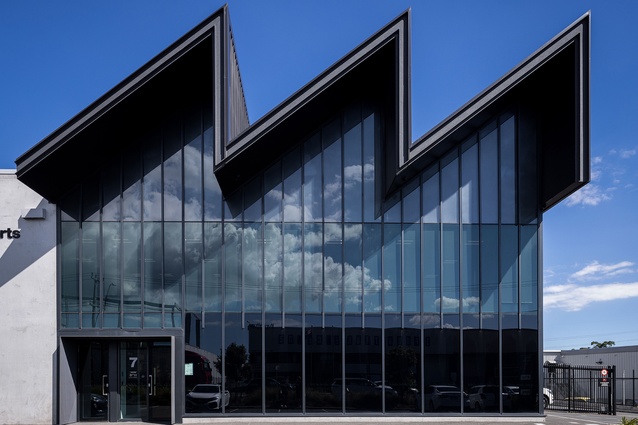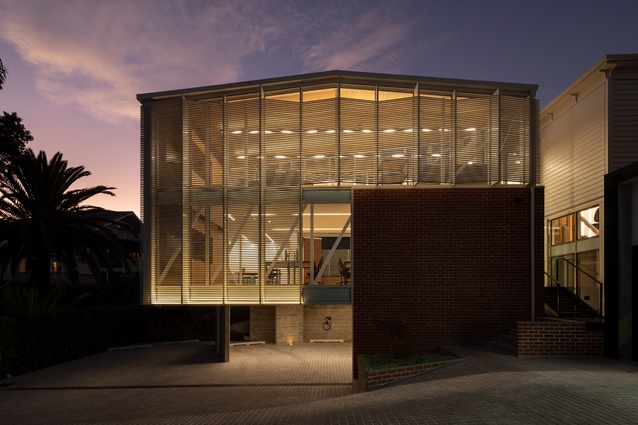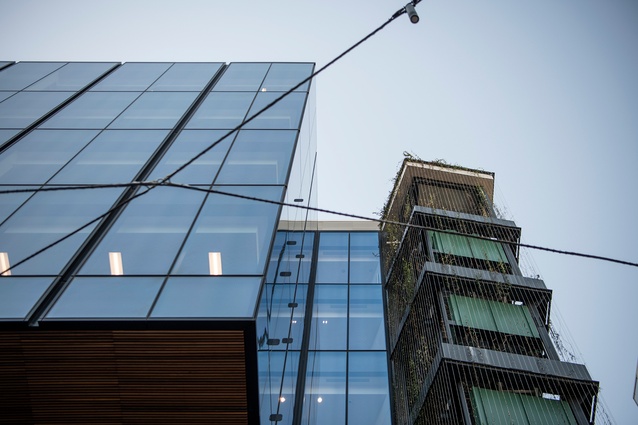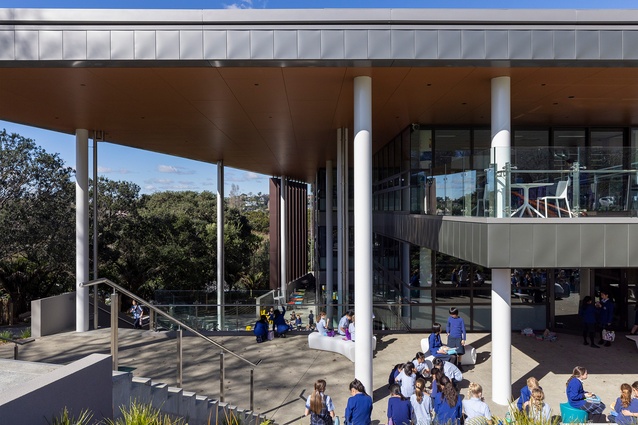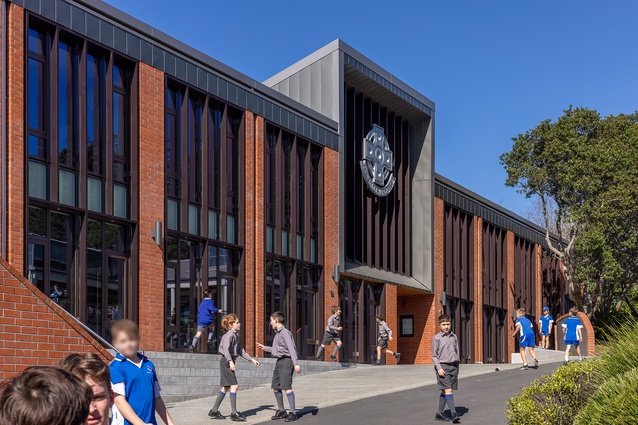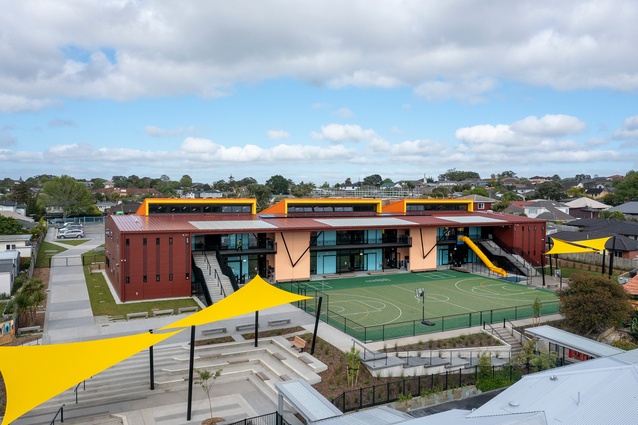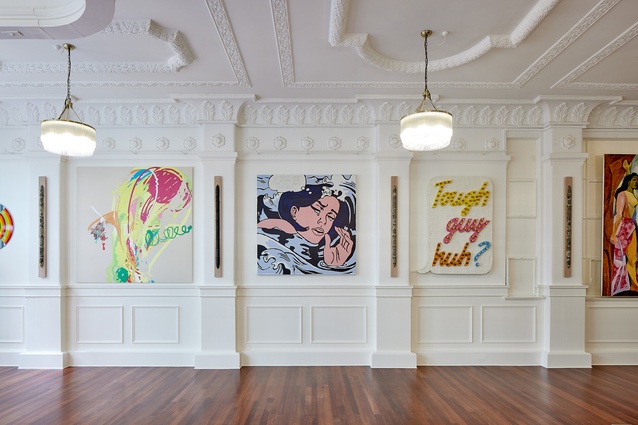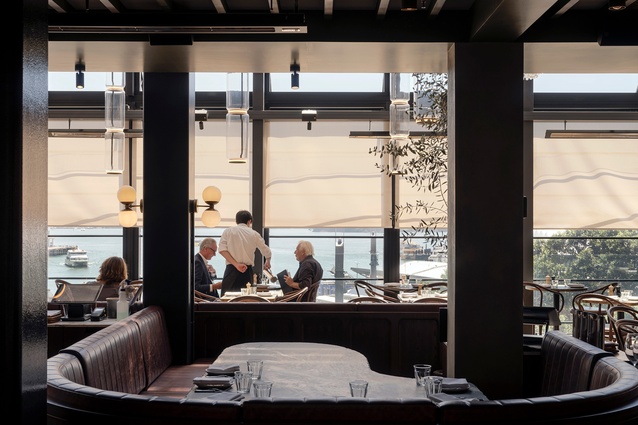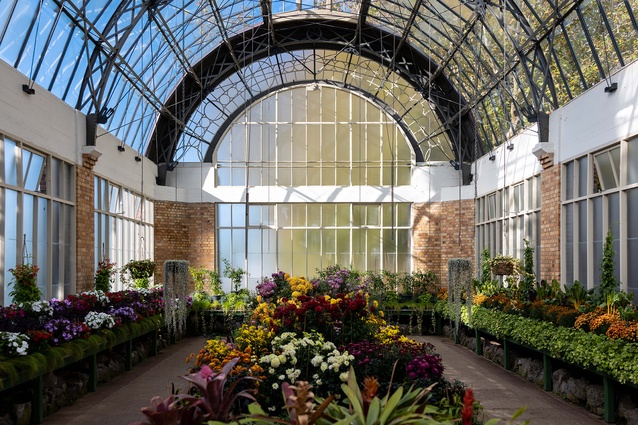Winners revealed: Auckland Architecture Awards 2023
A “heroic” education centre on a suburban marae, a West Auckland surf club that has become the heart of its community, and homes that were decades in the making have been deemed the very best in the Auckland region’s Te Kāhui Whaihanga New Zealand Institute of Architects Awards.
Fifty-six architectural projects have been recognised. The winning entries span twelve categories and can be found as far afield as Omata Beach in the Far North and Ramarama in the South. Each will be recognised at an event at the Viaduct Events Centre on June 8.
Te Taumata o Kupe Nuku, an education centre on Te Mahurehure Marae in Point Chevalier, earned a Public Architecture award for TOA Architects. The judges called it “heroic in ambition, reach and execution” and noted its unique sense of storytelling, imbued in the design and the materiality of the architecture. The Trusts Karekare Surf Lifesaving / Kaha Ropi, by 106 Architects and Richard Priest Architecture in association, was another public building to be celebrated for its design and its role, post-cyclone, as a community hub.
The Wintergardens at the Domain, designed by Gummer & Ford in 1928, were recognised with an Enduring Architecture award. The barrel-vaulted Victorian glasshouses were recently restored by Auckland Council and the facility has recently reopened to the public.
Twenty-nine homes that run the gamut from tiny budgets and footprints, to epic in scale and costs, were recognised across the Housing, Housing - Alterations & Additions and Housing -Multi Unit categories. Several were personal odysseys for their architects, because they were designed for their own families or for clients they’d worked with for many years, even decades; all were beautifully conceived and a testament to creating architecture through trying times.
“The calibre of work this year was very high and many of the projects were designed and delivered through the Covid period,” says jury convener Patrick Sloan of Sloan Architects. “These projects stand as testaments to the determination and commitment of the architects, their clients, the consultants, and the contractors in bringing these buildings to life.”
He says the jury were also taken by the pursuit of simplicity, evident across all categories. “Great design outcomes often come from a light touch as opposed to too much design and we saw this in so many of the projects we reviewed.”
Sloan was joined on the jury by Jane Hill of Chow Hill Architects, Yvette Overdyck of Stevens Lawson Architects, architect Kathryn Carter, and renowned retired architect Marshall Cook.
The winning projects are:
Housing
Ōhinerau House by Bossley Architects
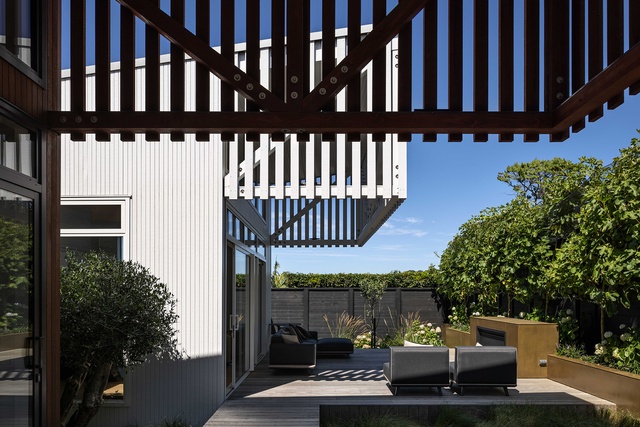
Understated and unassuming, there is a resolute simplicity to this house located on the side of Mount Hobson. Dual linear forms define an internal atrium that extends from the lower-level entry to living areas above, transitioning to an external landscape volume located deep into the floor plate. Externally, these forms project a calm and restrained presence to the street and give way at the rear of the house as permeable canopies over outdoor living areas. Planning solutions are straightforward and reasoned and combine with a restrained material and colour palette to produce a cohesive study on the suburban home.
Kauri by Bull O’Sullivan Architecture

This rural home is a celebration of family life and talks to the architect’s intensely personal approach to design, his humility and deep understanding of the client’s requirements. The external envelope of bespoke anodised aluminium panels sheaths a truly unique form that is at once completely foreign and completely at ease with its rural location. Defined by a series of beautiful collisions of contrasting materials, spatial dynamics and the play of light and colour, this project talks to the pursuit of exceptional innovation and the delivery of beguiling authenticity.
Kingfisher by Dorrington Atcheson Architects

Overlooking the upper reaches of the Waitematā Harbour, this home embraces its semi-rural setting with a collection of spaces and volumes that seamlessly connect to the landscape. The linear plan traverses a gently sloping site, providing views from the entry area through to the centre of the house, and to the landscape and waterfront beyond. It also carefully navigates an existing tree to form an external courtyard that connects the adjacent kitchen, media and living room. Robust, natural finishes and materials and a simple colour palette produce a down-to-earth home that responds superbly to its context.
Ridge Retreat by Francis Group Architects
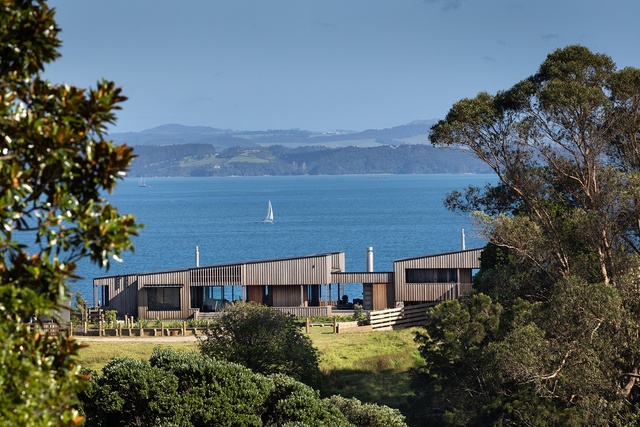
Perched on an exposed island ridge, this coastal retreat responds to a unique and personal design brief. Paying reverence to a nearby family home designed by the late Lillian Chrystall, the new home is entirely unassuming in its simplicity and self-assured in its ambition. Two mono-pitch building forms — one housing bedrooms and living spaces and the other guest accommodation — are connected by an external room more rectilinear in form. The use of natural-finish timber across the interior and exterior, in combination with exposed concrete block, produces a casual and laid-back atmosphere entirely suited to the coastal location.
Ponsonby House by Gerrad Hall Architects

This bold addition to a heritage streetscape contributes much to the debate around preserving Victorian design ideals. The small site is used wisely and responds well to planning restrictions, with an elevated gable emerging from a rectilinear base that presents a unique and light-hearted profile to the street. Internally, planning adjacencies dispense with traditional approaches — opening directly to rear living spaces, then out to the landscaped garden and pool. This approach, the use of light colour tones and superb levels of natural light, give the perception of greater volume than is provided on the lower levels. This new home is an excellent example of subtle disregard for the rules, executed in a delightful way.
Point House by Guy Tarrant Architects
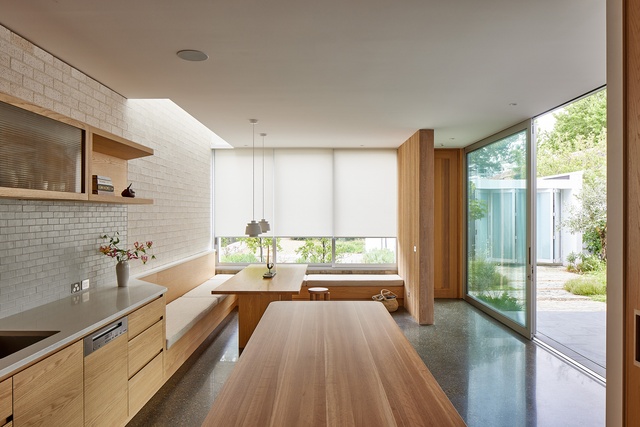
This thoughtfully conceived home is a simple floor plan extruded beneath an out-sized gable roof form to create a series of intimate living spaces. The resulting interplay of solid and void, and a seemingly perfect amount of natural light that delicately bathes interior walls, produces joyful serenity. This extends to an external living room beneath the gable and then into a finely crafted courtyard garden in contrast to the rambling community garden to the rear of the property. This refined project provides numerous lessons in combining straightforward planning solutions and minimal formal expression, with a limited material and colour palette, to great effect.
Resene Colour Award
The restrained use of whites, creams and greys combine with multiple natural-finish timbers accentuated by filtered natural light drawn deep into the house. The finely crafted spatial sequence that defines this home is decidedly tranquil and inviting, supported by the sparse application of subtle variations in the colour palette.
Omata Beach House by Herbst Architects
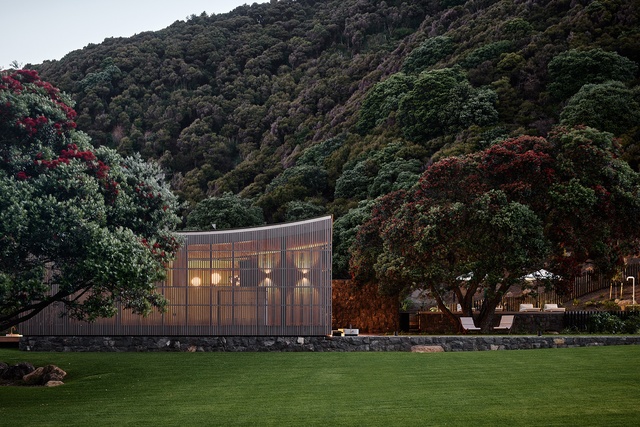
This exceptional home sits quietly in a pristine natural environment that provides cues to its form and ambition. The external material palette of timber and rock combines with two contrasting forms positioned carefully beneath pōhutukawa and as a backdrop to the exceptional views over the bay. The highly efficient linear plan sits beneath a sweeping roof form, dividing public from private in an effortless combination of spatial simplicity and reduced materiality. The architects on-going research and deployment of custom-external envelope solutions are beautifully articulated with exceptional craftsmanship and attention to detail.
Waimauku House by Jo Craddock Architecture
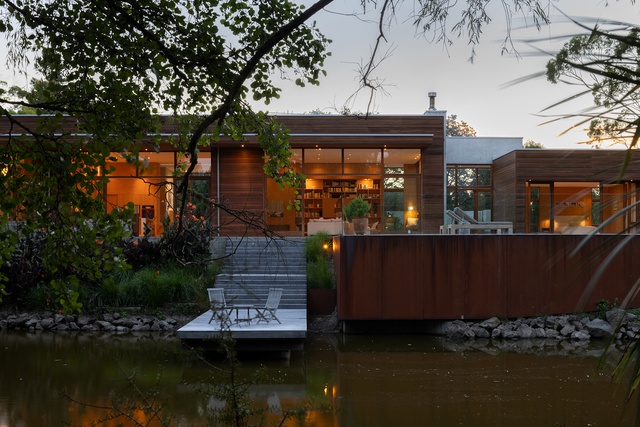
This home defies its antipodean location with an identity and character that wouldn’t be out of place in numerous rural settings around the world. In dispensing with traditional notions of New Zealand residential typologies, the house unashamedly claims the landscape. Significant in area and ambition, this home steps along a central spine, with various rooms and spaces extending out towards the landscape. Natural timber panelling and raw concrete planes frame the internal volumes and define the linear external form, while the substantial pool and outdoor living anchor and ground this exceptional home. At once robust and refined, this project adds much to the debate of what residential architecture can be in Aotearoa.
Angle Grinder by Mark Frazerhurst Architects

Inspired by a corrugated iron sculpture twisting down a hill, this home is a series of moments hand crafted by the architect and his parent-clients over the course of nine years. Located on a steep south-facing section, the landscape shelters the house from north-easterly winds, including a protected mid-floor terrace. This family odyssey delivers a delightful journey defined by inward and outward views offering visual relief to a sequence of stepped living platforms. The project is an innovative and uniquely detailed solution for comfortable living, despite the difficult suburban site.
Swallow Point House by Noel Lane Architects and Rowe Baetens Architecture in association

This home for an architect and his family is a collection of simple, low-profile pavilions that recede gently into a hillside location. The various living and bedroom zones extend diagonally across the site to capture the extraordinary views and are linked by a secondary layer of halls and passageways that also provide privacy and seclusion. The design approach pursues simplicity over complexity, and this extends to the reduced material and colour palette that provides a backdrop for artwork internally while blending seamlessly with the landscape externally. Significant in many ways, this project is also measured and sensitive, it talks to the architect’s deep appreciation of landscape, identity and a sensibility that effortlessly responds to context.
Brick House by Sayes Studio
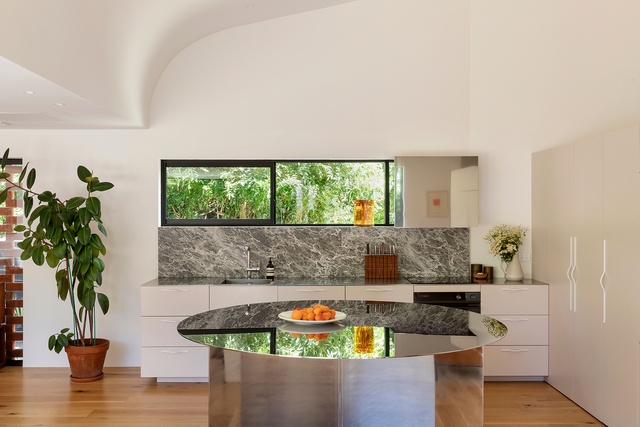
Completed as the second instalment in an eventual trio of homes, this project is a meditation on restraint and simplicity. Designed by an architect for his family, the modest home is compelling in plan, section, volume and attitude, contributing a great deal to the ongoing debate around housing affordability in New Zealand. Generous living areas open to a peaceful external terrace that extends the internal volumes. Bedrooms are tucked away above the main living areas, clearly demarcating public and private zones. The external character is a result of simple, robust materials overlayed to subtle shifts in form and planar orientation.
Apple Shed by SGA – Strachan Group Architects
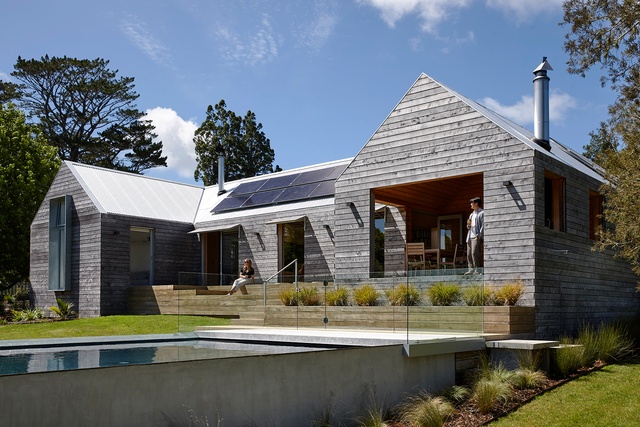
This modest home is inspired by local horticultural history. Adopting the aesthetic of the apple crate, a rural form is beautifully crafted to create a home that belongs to its landscape. The design solution contains a clever sequence of internal volumes that draws light deep into the interior — and in combination with a simple palette of materials and textures, generates a warm and relaxed environment. Reduced, minimal and without pretence, this project illustrates so clearly how simplicity in design is the most sustainable strategy architects can employ.
Garden House by SGA – Strachan Group Architects
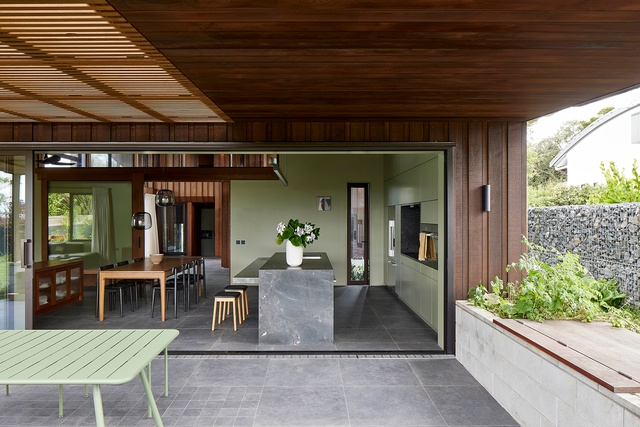
Located on the threshold of a suburban development, this home is planned around the complexities or long-term health care and quality-of-life considerations for its owners. The architect has delivered a comprehensive suite of innovative design solutions that will allow use and functionality to evolve over time. Generous internal spaces lined in cedar flow seamlessly to the gardens and external terraces beyond, where the application of the cedar continues. Sustainable design is at the core of this project, with numerous passive and active strategies deployed throughout an unassuming yet sophisticated home.
Seaward House by Space Division

This home is modest in appearance, yet with generous intent. Originally an alteration and addition, the project eventually became a substantial new build above an existing basement. Thoughtful planning separates public and private realms, with living areas located on the lower levels and accessed from a concealed side entry. This significant volume opens north to the terrace and pool with unimpeded views to the Waitematā. Understated and restrained on many fronts, this project is instructive in its combination of clean, contemporary design with Passive House Plus certification.
Maungakiekie House by Space Division
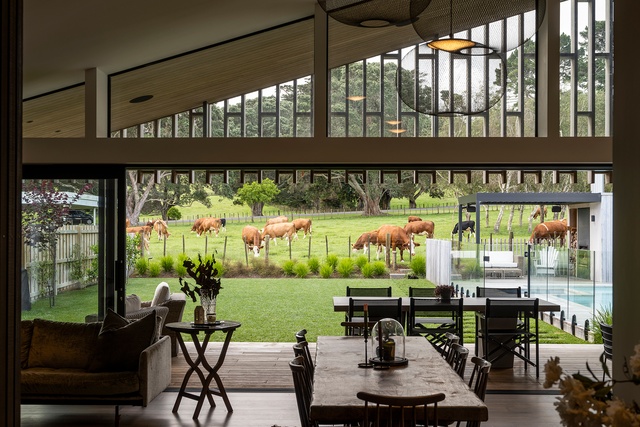
This family home projects two distinct identities — a robust urban presence on a main arterial road in contrast to a softer, permeable character facing the rural-like landscape of Cornwall Park. The division of public and private is well handled with a planning solution that clearly demarcates function and use. Views to the park take in pastures and grazing animals and reflect the owners’ desire to connect with a rural landscape, yet have the convenience of urban living. While significant in area, this family home is modest in character and attitude and is well suited to its unique location.
Our Backyard House by Studio TT

Designed by an architect for her family, this townhouse provides for current needs while also allowing for the future development of an adjacent site. The house presents a sophisticated street presence, with a large window positioned as a venue for displays that celebrate annual events. The external courtyard adds depth to the street frontage and forms a peaceful retreat from the road, extending the living space into a calm, sun-drenched oasis. The refined material palette, use of colour and texture, combine to create a relaxing environment concealed behind a cohesive urban presence on an otherwise suburban street.
Tāwharanui Pavilion by Wendy Shacklock Architects
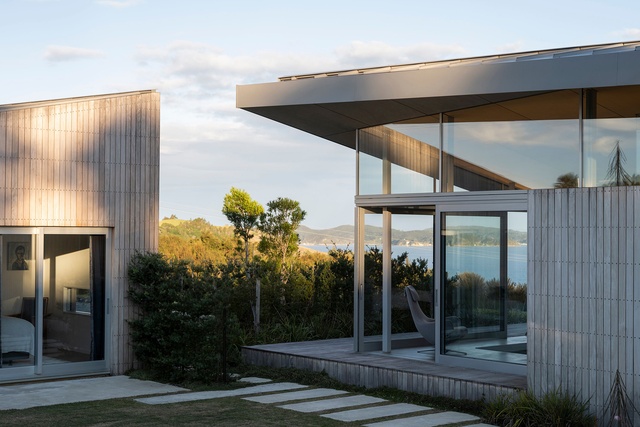
This project engages the fifth elevation with carefully considered roof forms defining a dramatic arrival sequence that commences above the site. Simplicity and complexity combine in this rural home, where the folded roof plane hovers above a sequence of internal rooms contained by three-quarter-height walls, with a finely detailed glazed panel to the underside of a floating ceiling. The subtle, muted tones of natural-finish timber and-board-form concrete to the interior sit quietly as a backdrop to long-range views out to sea. The more restrained guest quarters extend the geometry and profile of the main building and complete a finely crafted duo of buildings.
Housing – Alterations & Additions
Keene Family Home by Bull O’Sullivan Architecture
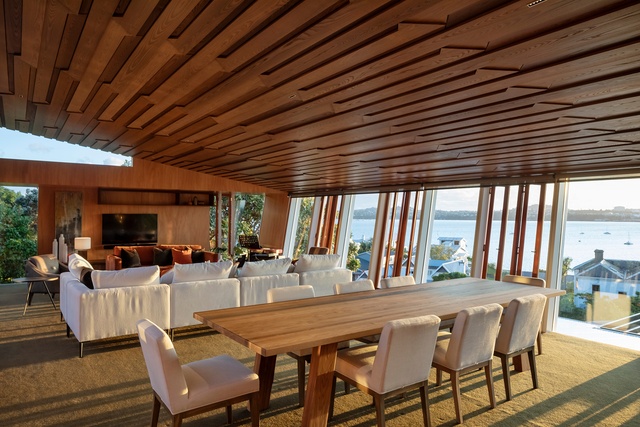
The project integrates the beautiful restoration of a bungalow with a substantial new addition that extends up the steep site to the rear. Three light-filled stairs along the western boundary connect the five levels of this home, which for first time visitors unfolds like a journey of discovery. The rich use of colour, crafted detail, texture, native timber and cork provide a sensory experience and illustrates the architects fearless approach to design experimentation. Views across the water and back to the city are captured at every opportunity — framed by the unique and evocative spaces that define this distinctive reinvention of a Devonport home.
Resene Colour Award
Dramatic, adventurous, and truly authentic combinations of colour define the numerous spatial attitudes that make up this fascinating family home. Natural stone, cork, timber, glass, carpets, paint and a variety of applied finishes combine in a reverie of colour.
Jewellery Box by Crosson Architects

Defying expectations to blend existing with new, this alteration to a family home breaks the rules to become a beacon in its island context. The new addition stands alone in stark contrast to the original building and is accessed through a glazed bridge that steps up into the new living area. The generous volume is flanked by two new bedrooms and a bathroom, beneath a multi-purpose living space with slots of glazing to the wall and roof planes. Exceptional craftsmanship of the internal plywood lining is complimented externally by the timber-shingle envelope over a sculpted yet highly functional form.
Lion Head House by Fearon Hay Architects
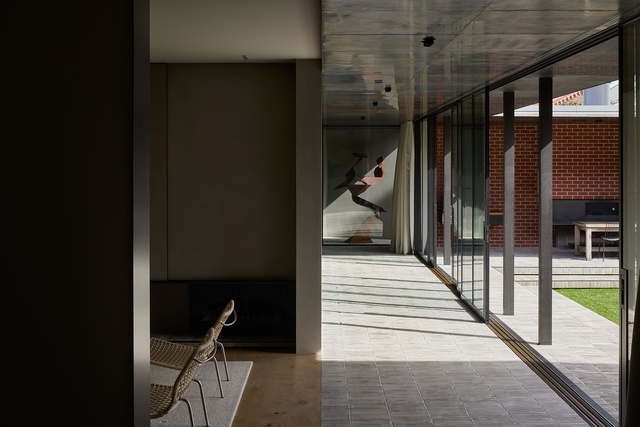
Superb attention to detail and craftsmanship defines this addition and alteration, in which no corner has been left untouched. The original character of the home is retained, enhanced and its capacity extended with a thoughtful, contemporary addition that frames the external landscape experience. Appropriate reverence is served to the original construction and materiality where the home is maintained as ornate and traditional. With its contemporary design overlay, this subtle and timeless approach will ensure the home is enjoyed for decades to come.
Omata Hill House by Herbst Architects
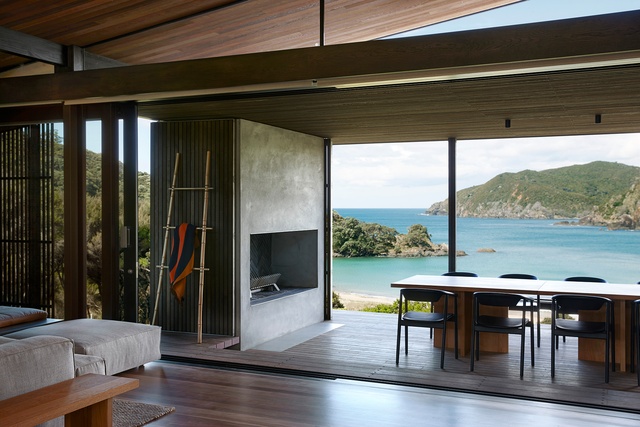
While an alteration and addition, the extent of work and the sophistication of its execution provides the same level of quality that may be expected from a new home. Connections with the landscape and nature are established with a permeable, open living space and are further encouraged with a transition from inside to out when moving from living spaces to bedrooms, at either end of the house. Outdoor areas extend the main living space with shutters allowing for variable weather conditions, while meticulously detailed timber lining adds warmth to the interior. This project is a superb example of the inherent sustainability of re-tasking an existing building.
POOLSCAPE by Lloyd Hartley Architects
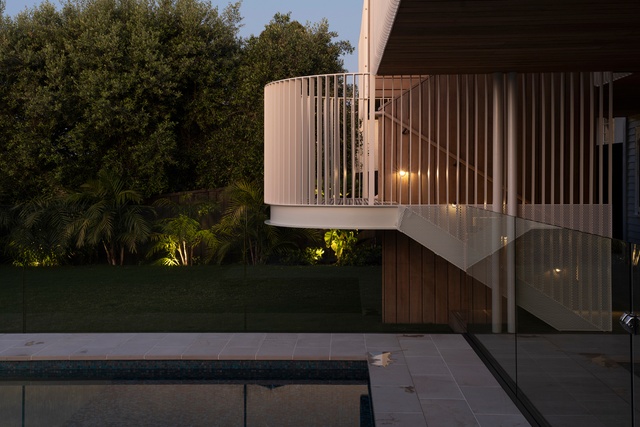
This well-conceived project is the renovation of an existing home to cater to the needs of a growing family. The substantial north-facing verandah extends the living areas of the upper levels with a sophisticated all-weather operable envelope providing both sunshade and protection from the wind and rain of inclement weather. These elevated outdoor living areas connect to the lower-level and landscaped pool areas with an exquisite external stair which clearly illustrates the architect’s expertise in innovative detailing and managing the construction execution.
LANCASTER – The Luxury of Enough by Lloyd Hartley Architects
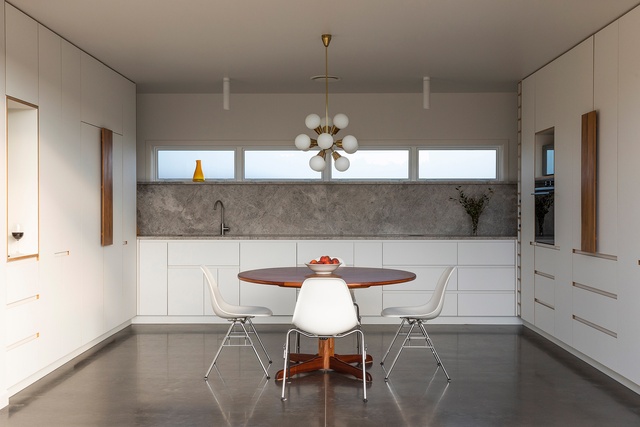
This alteration responds carefully to the constraints of a limited budget to address the needs of a growing family. Expenditure focused on the areas of greatest value for the family while also delivering a wide range of innovative yet cost effective design solutions. Modest in size and scope, the project is defined by a series of individual retreat and sleeping spaces for each family member – these contrast with family spaces designed for flexible use. The bold use of colour, superb detailing, cost-effective materiality, and a variety of unexpected and charming moments combine in this sophisticated, expanded family home.
Resene Colour Award
The public and private zones of this family home are defined by colour coding. Subtle muted tones and a variety of white define the new living areas, which contrast to vibrant colours in the bedrooms of the revitalised house.
Shift House by MAUD
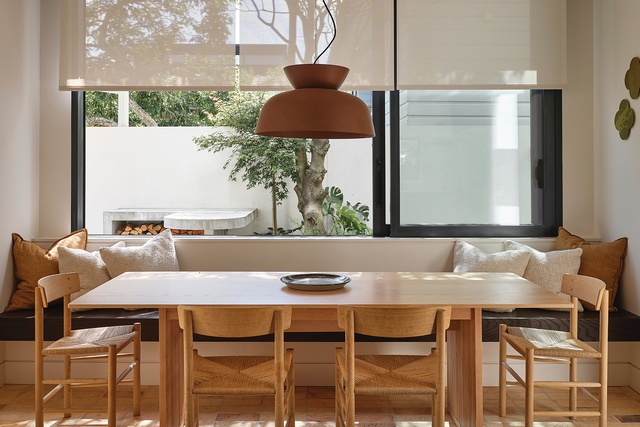
Through a considered study in scale, plan and materiality, this alteration transitions from a traditional villa and the streetscape of a Special Character Area into a sophisticated contemporary family home at the rear. Context, materiality, comfort and sustainability were key drivers in a design response that carefully manages the combination of old with new. Salvaged materials are used to great effect, including bricks re-tasked as floor tiles and kauri timber used in a variety of ways throughout the house. This fresh and innovative take on a well-known renovation typology is modest in ambition yet it delivers a series of exceptional design solutions with effortless poise and sophistication.
Resene Colour Award
Unique and thoughtful combinations of a broad palette of materials and finishes, including recycled brick as floor tiles, define the interior of this character home. The use of neutral colours in the main living spaces contrast with deep green and red tiles and richly veined stone in the bathroom areas.
Gable Extension by Sayes Jackson Architects

The traditional street frontage to this Westmere bungalow conceals a dramatic addition to the rear. Breaking with convention on a well-known renovation typology, this superb new living volume is defined by a simple gable roof form combined with the extensive use of natural-finish cedar, to stunning effect. Every beam, rafter, post and finishing element has been carefully considered, composed and aligned with a meticulous attention to detail that talks to the architect’s command of the design, documentation and project delivery process. This project is a lesson as to what’s possible when a single idea is defined, pursued and then executed with near flawless precision.
Resene Colour Award
The extensive use of natural-finish cedar and the limited use of dark-tone elements combine with muted stone surfaces and neutral surface colours. The resulting visual harmony and sense of calm is transformative and frames a seamless transition from the internal spaces to the landscape beyond.
Housing – Multi Unit
Kōtuitui Terraces, Stage 2 by Crosson Architects
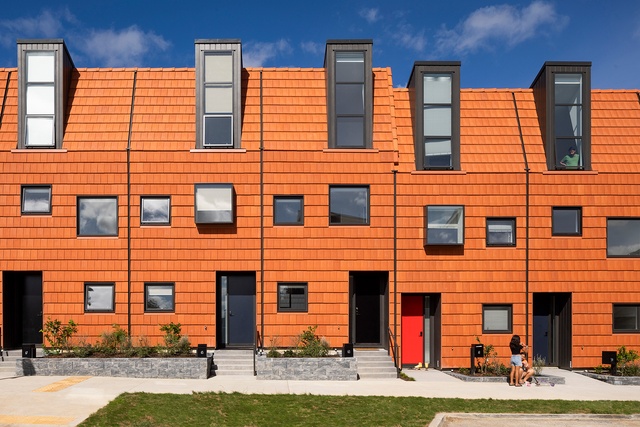
This ground-breaking project proves that low rise, multi-unit housing in New Zealand can be unique, affordable and truly inspiring. Simple planning strategies combine with innovative formal expression and material application in ways that defy the project’s antipodean location. The inventive design approach extends to the placement of windows and entranceways, establishing a lyrical dialogue with the street while providing active engagement and requisite levels of privacy. The design outcomes of this superb project, on multiple fronts, are at once unfamiliar, somehow intuitive and a welcome breath of fresh air.
Resene Colour Award
The ambitious and theatrical use of colour defines the identity of this sophisticated urban project. The large expanse of a single colour form is punctuated by window apertures and entranceways in primary colours and recessed timber elements.
Awarua Trio by Megan Edwards Architects
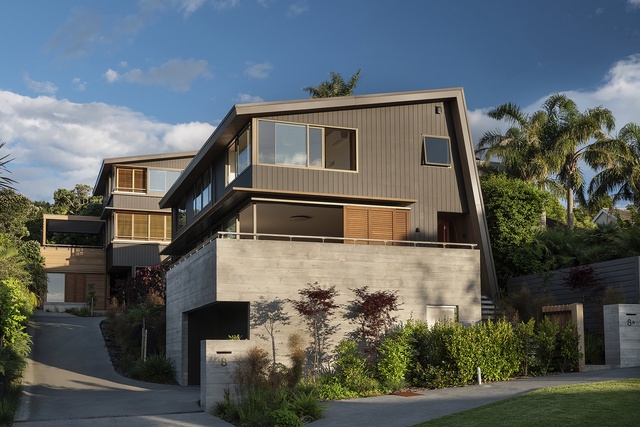
This elegant example of multi-generational living sets a new benchmark for the low-rise intensification of inner-suburban Auckland. Careful distribution of floor levels and windows provides access to superb views from numerous locations across the sophisticated development that carefully navigates a sloping site. The folded wall-to-roof element links the separate dwellings and transitions to an exceptional internal element. This project is a rare example of thoughtful, well-built in-fill housing that inspires and contributes to the debate around how density doesn’t necessarily preclude quality.
Jervois Apartments by Monk MacKenzie
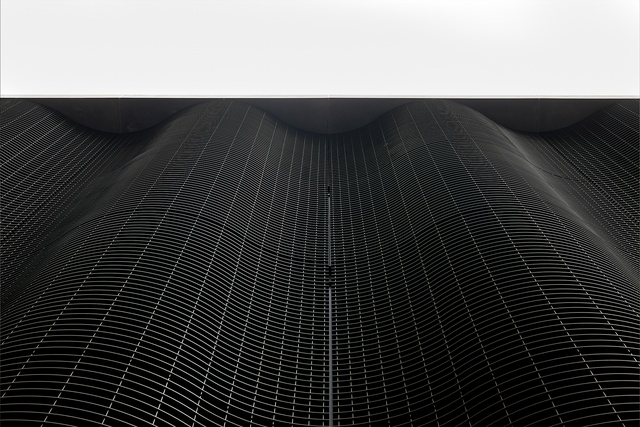
Simple, restrained and understated in so many ways, this project is an impressive example of how urban developments can engage with the public realm. Designed in response to a range of complex planning constraints, the curvaceous veil to the street defines the project’s identity while performing the more functional roles of balustrade and privacy screen. In plan, the building is no more than it needs to be, with linear apartments drawing light and ventilation in at both ends while providing exceptional views across the city and horizon beyond. This ambitious and remarkable project establishes a new benchmark for medium-density residential development projects in Aotearoa New Zealand.
Cohaus by Studio Nord
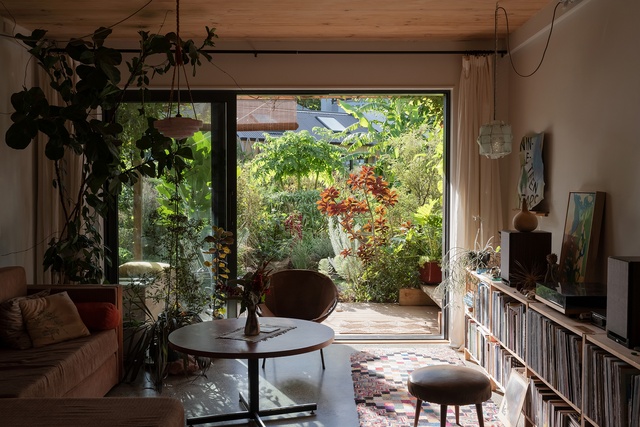
The understated street presence of Cohaus conceals a rich internal complexity and a tight-knit community. The result is a new typology for medium-density housing in Aotearoa New Zealand, with shared facilities providing a range of community benefits. Sustainability defined this project from the outset and now provides residents with significant savings on energy and water costs. Various design strategies, construction methodologies and material solutions are combined to deliver a cost-effective, yet entirely pleasing design outcome. As New Zealand continues to navigate complexities and challenges across the housing continuum, Cohaus establishes a new bar to which future multi-unit projects should aspire.
Interior Architecture
Faradays by Cheshire Architects
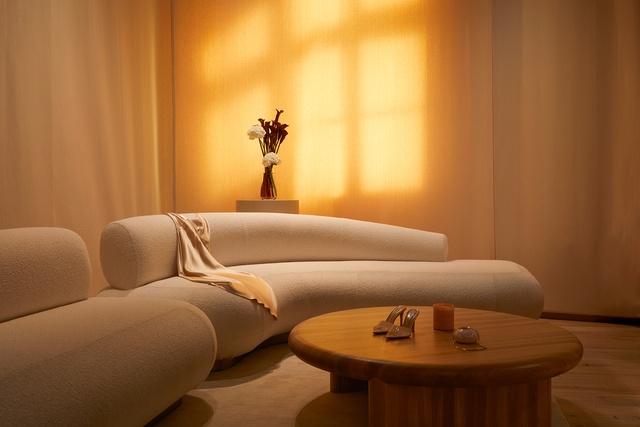
This beautiful project is defined by a journey of surprise and fascination as visitors are drawn deeper into the space, navigating a series of sculpted displays, niches and corridors. The heritage of the old warehouse building is stripped back to original timber and provides a superb contrast to an eclectic mix of sinuous fabric planes, stone slabs and floral displays. Meticulous detail mirrors the workmanship of many of the items carefully displayed for sale and combines with a cohesive lighting strategy to deliver a unique retail experience. Completed with a remarkably limited budget, this project clearly illustrates that fabulous design outcomes are possible regardless.
Whangārei Māori Land Court by GHDWoodhead creativespaces and Studio Pasifika in association
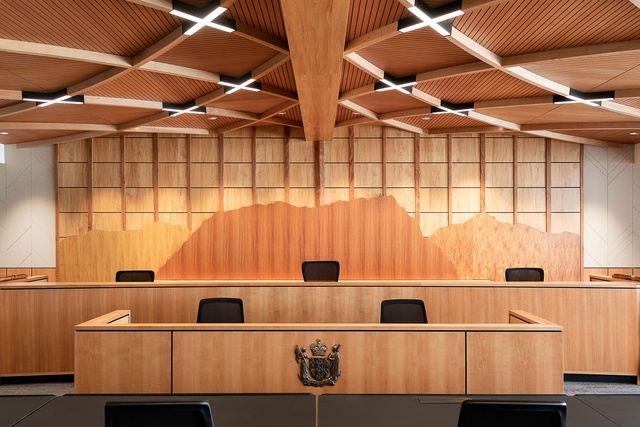
This important public facility recognises Te Ture Whenua land as a taonga tuku of Māori. Welcoming and accessible, the retrofit of a former business centre now provides a courtroom, ancillary spaces for the judiciary, interview and research spaces, and a library of ancestral records for tangata whenua. The courtroom proper is a reflective space installed with wharenui imagery created by Carin Wilson that reflects the history of local iwi and engages te ao Māori principles. The space is rich in narrative with motifs on tōtara beams, tukutuku panels to the walls, the carved judicial bench and upholstery fabrics designed by Maxwell Rogers. This contemplative space is calm, inviting, conciliatory and peaceful, and now exists as a benchmark for similar courts and venues of public engagement.
Isthmus Studio 246 by Isthmus Group
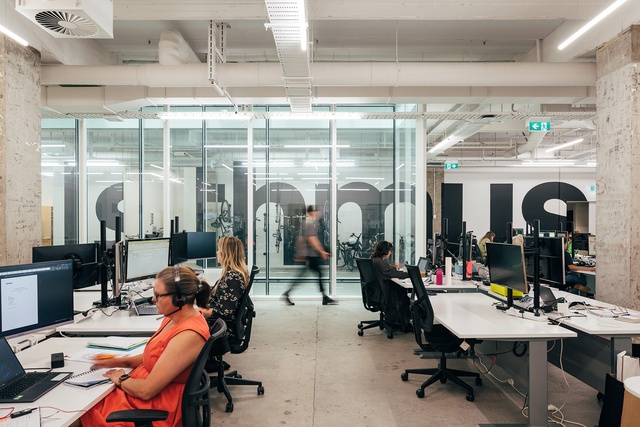
An admirable commitment to central-city revitalisation underpins Isthmus Group’s move to their new studio located in the heart of Queen Street. Immediately welcoming, this regeneration of a traditional office floorplate employs an industrial aesthetic in combination with a generous approach to planning. The open-plan solution, while familiar, results in boundaries between design disciplines and functional zones that dissolve when necessary — to be re-established when required. Spatial allocation and circulation routes combine in an effortless ebb and flow that inspires creativity and collaboration in this sophisticated take on the multi-discipline design studio.
Planning & Urban Design
Ngā Hau Māngere – Old Māngere Bridge by Bossley Architects
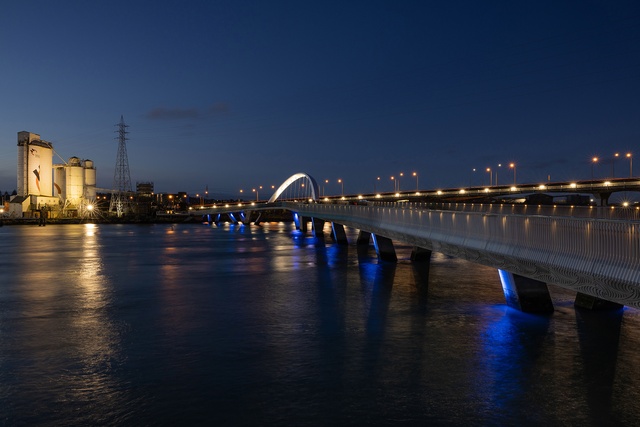
This elegant piece of public infrastructure spans the Manukau harbour at Onehunga — once a traditional meeting point for Māori and close to original portage crossings to the Waitematā. The bridge deck and fabricated steel arch combine with artwork and the kahawai-inspired coloured balustrade in a compelling illustration of long-held mana whenua connections to land, sea and sky. With sight lines north to Maungakiekie One Tree Hill and south to Māngere, the bridge provides passage for pedestrians and cyclists and has become a much-loved fishing venue. Innovative and grounded through narrative, intent and a true sense of place, this community destination is an inspirational asset for people across Tāmaki Makaurau.
Resene Colour Award
The combination of functionality, visual appearance and identity of this project is exceptional. The application of graduated colour to an otherwise utilitarian balustrade recalls the tones and hues of nearby mangroves, kahawai, and water that the bridge spans.
Public Architecture
The Trusts Karekare Surf Lifesaving / Kaha Ropi by 106 Architects and Richard Priest Architecture in association
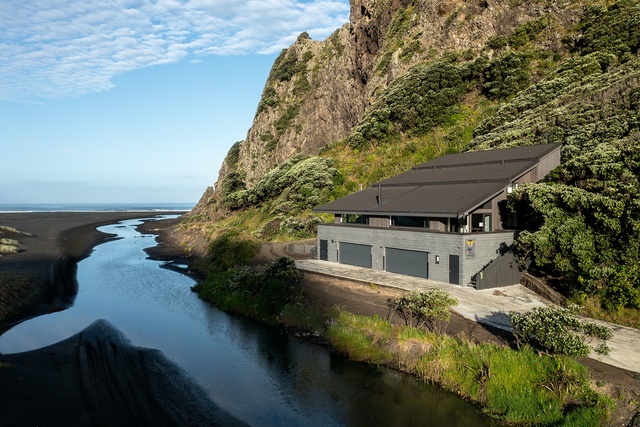
This project represents all that is good about community engagement and commitment. The unassuming building pushes into the base of a mountain on one side, while pushing back on an unforgiving natural environment on the other. The interior houses essential functions in spaces, nothing more and nothing less than they need to be, similarly, the exterior is defined by a simple mono-pitch roof that follows the contour of the site and extends into the trees beyond. In combination with a subdued material palette, this simplicity significantly reduces visual impact on the pristine natural environment and defines a new community heart.
Hundertwasser Arts Centre with Wairau Māori Art Gallery by HB Architecture, Hundertwasser Non-Profit Foundation and Springmann Architektur in association
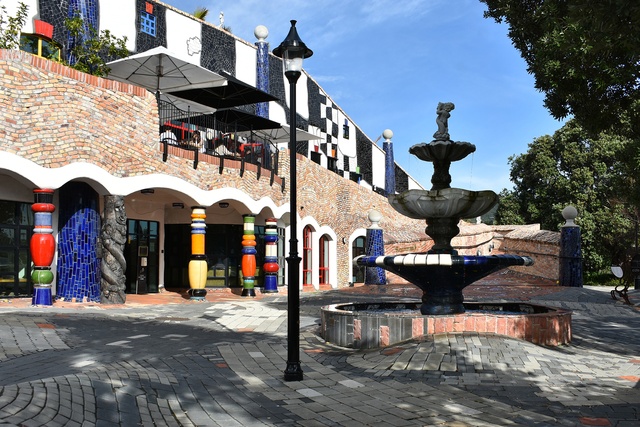
This refreshing addition to Whangārei’s evolving waterfront may be seen as the latest chapter in Hundertwasser’s relationship with Te Tai Tokerau. His intensely personal approach to art and architecture has perhaps found the expression he sought when he arrived in Aotearoa 50 years ago. The project validates many of Hundertwasser’s ideas and aspirations and, while not necessarily a building of its place, it pursues and ultimately defines its own context in the public heart and mind. The architect has carefully navigated a unique and complex design and delivery process to provide Whangārei with a new cultural icon and important tourist destination.
Te Taumata o Kupe by TOA Architects

This project is heroic in ambition, reach and execution. It is a remarkable result following decades of work and commitment from numerous people and speaks to the determination and perseverance of the Te Mahurehure community. As part of the wider marae complex, Taumata o Kupe embodies the spirit of Kupe and represents his journey to Aoteoroa. The unique external form frames stories and histories embedded in the glass window wall, which in turn projects shadows deep into the building interior where a collection of dynamic spaces and volumes provide for a variety of uses and functions. This exceptional project establishes a new home and a new way of informing and defining the future for the people of Te Mahurehure Marae and the wider community of Tāmaki Makaurau.
Resene Colour Award
The vibrant, dynamic and rich colour palette used across the external envelope and throughout the interior ground this project firmly in the narrative from which it originates. Meaning and intent are illustrated in compelling ways and talk to the cultural significance and community contribution of this project.
Small Project Architecture
Te Pae by Crosson Architects

Unique in so many ways, this sentinel in the dunes is robust in materiality to withstand the coastal weather, yet recessive in appearance with its black-oxide concrete shell peering out over the landscape. Circular in form and as a functional requirement, it provides uninterrupted surveillance out to sea and along the coastline. This highly functional building peels away from the often-relentless wind while providing a calm and focussed environment for observation and patrol — its rugged aesthetic transferring to the concealed spiral stair, executed with superb utilitarian detailing. A sophisticated, ingenious response to a harsh environment, this innovative and commanding design is immediately recognisable for the important purpose it serves.
Camera Obscura – Timatatanga Hou by Felicity Christian Architect
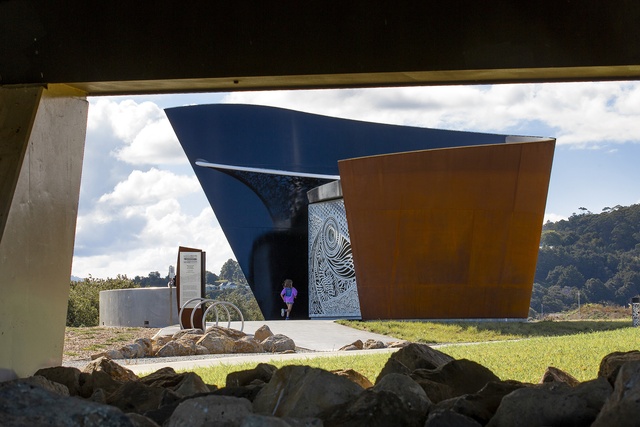
This project establishes a unique urban dialogue with Whangārei’s Te Matau ā Pohe bridge on the Hātea River. The sculpted steel form recalls the bow of a ship and speaks to a maritime history, while artwork draped across the form illustrates local Māori history and tradition. The mollusc-like shell draws visitors into the cavernous space, eventually giving way to the inverted projection of movement and the sound of vehicles using the bridge. Dedication, aroha, commitment and generosity define this project so kindly gifted to the people of Whangārei.
Garden Studio by Glamuzina Architects
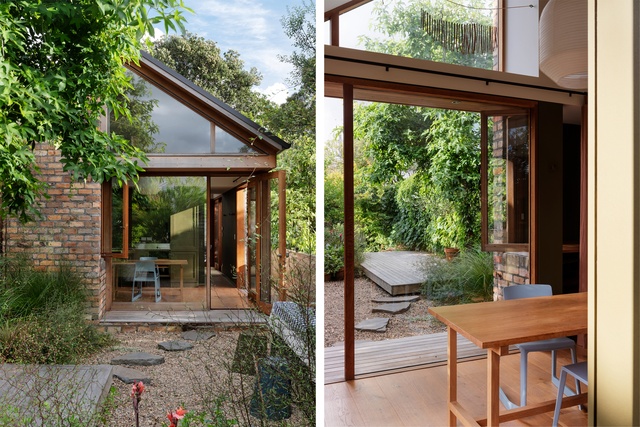
Concealed behind a small Ponsonby home, this studio bookends and formalises a rambling courtyard garden. Secluded and peaceful, the cedar-clad workspace with an asymmetric gable roof peacefully merges with the roof forms of surrounding houses and canopy of trees in Vermont Reserve to the south. The studio establishes dialogue with the main dwelling along the narrow site – echoing its form and in preparation for an extension planned to connect the two buildings. Hand-crafted details provide a bespoke, timeless and reflective quality to this superb project that offers so much more that its scale suggests.
Resene Colour Award
Blending seamlessly with natural timber finishes and the surrounding garden, a limited colour palette of brown and green combines with subtle blue-grey tones in the furniture and ceramic tiles to create a serene space conducive to quiet contemplation and focussed work.
Grasslands Studio by Keshaw McArthur
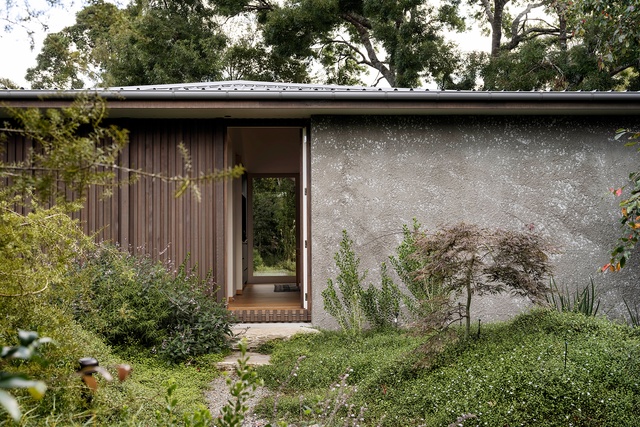
The project belies its suburban location and could easily be located deep in the countryside. The architect has deftly crafted a building that relates to its context, yet somehow talks of another place. Modest in ambition, the Grasslands Studio combines simple forms and design strategies with pared-back materiality and technical simplicity to great effect. The planning solution for this project is incredibly straightforward — its minimalist principles so clearly illustrated they remind us that small is more often than not, truly beautiful.
A Diaphanous Design by Lloyd Hartley Architects
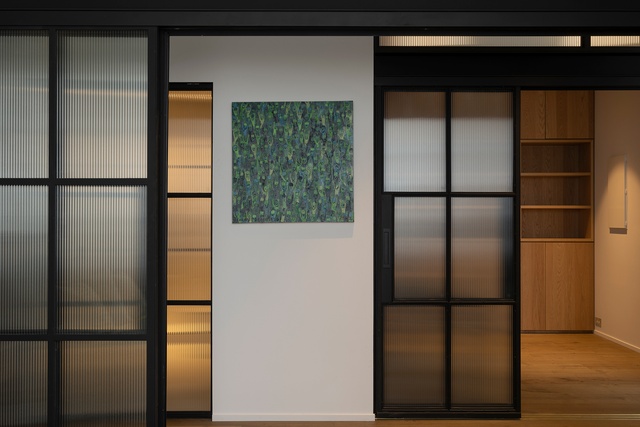
The refurbishment of this modest central-city apartment exposes building structure and reveals much of the buildings original character. The exposed slab and beams, now forming the ceiling, increase the internal volume and in combination with western light, suggest an apartment much larger than it is. The light is further utilised with dual layers of operable glazed shoji-type panels that project light deeper into the floor plate to the internal rooms. Steel beams, cabinetry and exposed conduit are integrated into the space, resulting in a comfortable, elegant and sophisticated industrial aesthetic.
Eden Terrace Home by Megan Edwards Architects
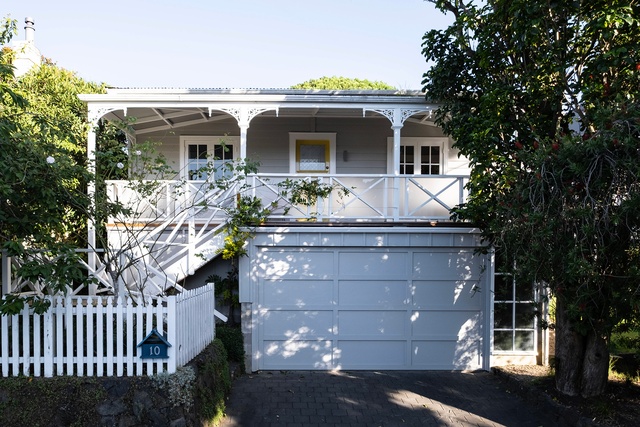
This modest alteration to a cottage provides much-needed space and enhanced functionality for a growing family. Located close to the North-Western motorway, the extension to the rear of the bungalow is a remarkably peaceful series of spaces that flow out to the garden. Clerestory glazing to the north and a perimeter of windows draw light deep into the interior, illuminating clever combinations of natural timber and various applied finishes. The project responds exceptionally well to the constraints of location, site and budget, and is a family home in the truest sense — welcoming, personal and well loved by its inhabitants.
Commercial Architecture
Woollen Mills by JWA Architects
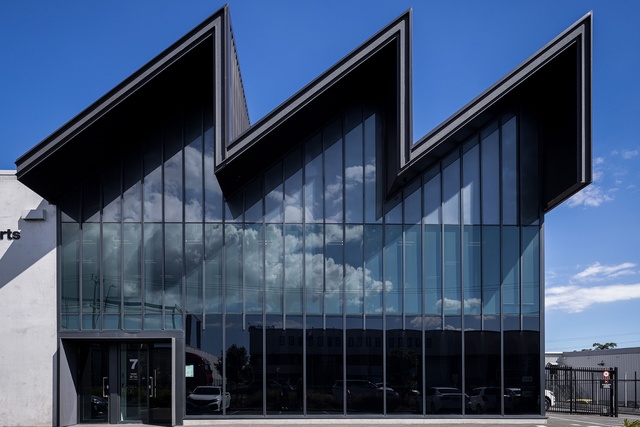
This thoughtful design response to a utilitarian typology establishes a new bar for large-scale industrial developments. Anonymity is replaced with identity and character in a simple, yet effective ensemble of standard building components combined in unique and considered ways. The saw-tooth roof form facing a busy road is commanding alongside its neighbours and establishes an engaging new presence in the surrounding context. Deep into the site, the functional loading and back-of-house areas are afforded a measure of design and in this sense, the project is instructive in how and why otherwise ordinary buildings can benefit greatly from thoughtful design initiatives.
Simon James Showroom & Office by Keshaw McArthur
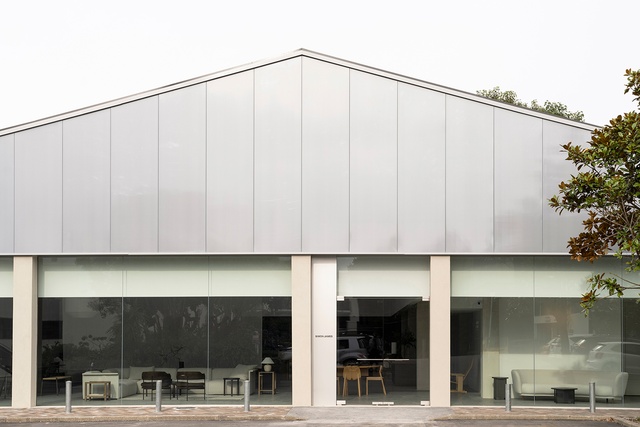
The architect has transformed a generic urban warehouse into an elegant, understated and world-class showroom. A disciplined study on the authenticity of materials and a measured resistance to over-design is evident throughout this exquisite retail destination. An eye for materiality and craft scaling to the beautiful detailing of window joinery, handrails and hardware. Mass, volume and light have been expertly explored in a showroom that provides a timeless backdrop to the work of one of Aotearoa’s most accomplished designers.
Pink Palace by Matter
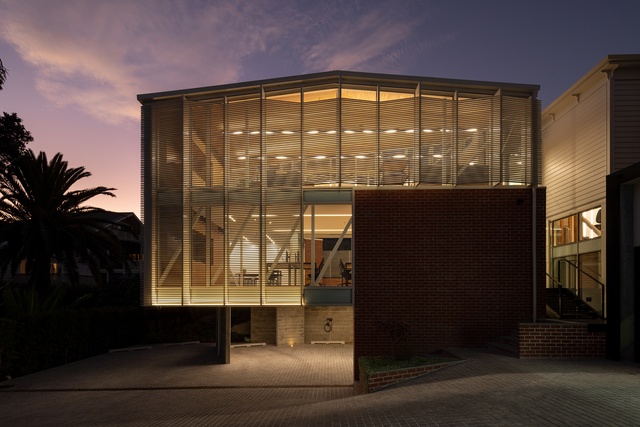
Hovering on the edge of the central business district, in a largely residential area, this project transforms and extends a traditional villa by claiming a discreet new home for itself on a complex, sloping site. The insertion of an external terrace and a central circulation volume connects the existing building with the new, creating transparency and a relationship to nature for these highly crafted office spaces. Demonstrating a deep appreciation of the value of careful, nuanced planning and immaculate detailing, this collection of urban workspaces is nothing short of exceptional.
Resene Colour Award
Multiple applications of white-on-white combine with exposed concrete surfaces, red brick and timber floor, wall, and ceiling treatments. These restrained combinations provide a flexible and unassuming backdrop for a variety of commercial tenancies and corporate identities.
Ponsonby Central - II by Paul Brown & Associates and Bernau Architecture in association

Conceived as the second stage to the original Ponsonby Central development, this medium-density, mixed-use project is a typology now possible along the ridge line of Ponsonby Road. Effectively a building in the round, the project engages in numerous modes with tenants, patrons and the surrounding context. While significantly larger than its residential neighbours, its impact is carefully tempered by setbacks to upper levels, a permeable ground-level perimeter and a series of articulate formal and material combinations. The project celebrates the street and continues the evolution of the activated laneway and pedestrian-oriented networks now redefining Ponsonby Road as a multi-layered precinct.
10 Madden by Warren and Mahoney Architects

Another sophisticated contribution to the Wynyard Quarter Innovation Precinct, this ambitious project raises the bar for sustainable design in mid-rise commercial and mixed-use developments. The 5-Star Greenstar Office rating illustrates the value of embedding sustainability early in the design process, and the innovative use of an external, stand-off core breaks with convention and allows for highly flexible floor plates and tenancy options. Bold forms and robust materiality combine to recall the industrial past of an urban precinct transformed and re-tasked for people. The project represents long-range, strategic thinking with a building set to come into its own as the precinct grows and the critical mass of people and activity increases.
Education
Saint Kentigern Girls’ School by Architectus
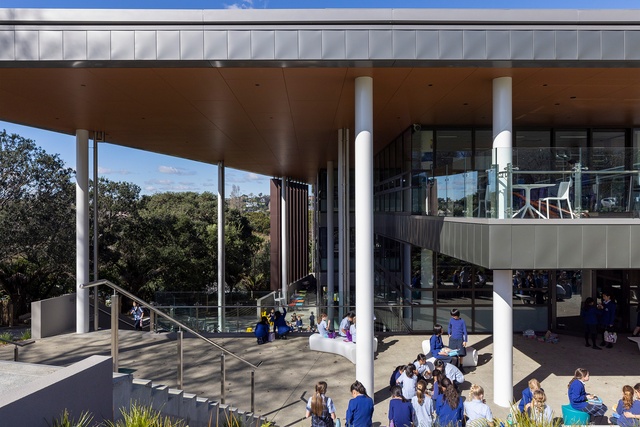
This project is a superb example of the architect’s command of the building section. Carefully working with its context, the new facility comprises a series of learning terraces elegantly stepping down the site. The robust street presence contrasts with a lighter and more permeable perimeter facing the school’s interior. Internal spaces and circulation pathways exhibit a clear planning logic with the library and learning commons at the heart, binding the school together and encouraging interaction. The cohesive sequence of innovative learning environments is an inspiring place for students to be themselves, while staying connected to a larger learning community.
Saint Kentigern Macky Building and Specialist Facilities by Architectus
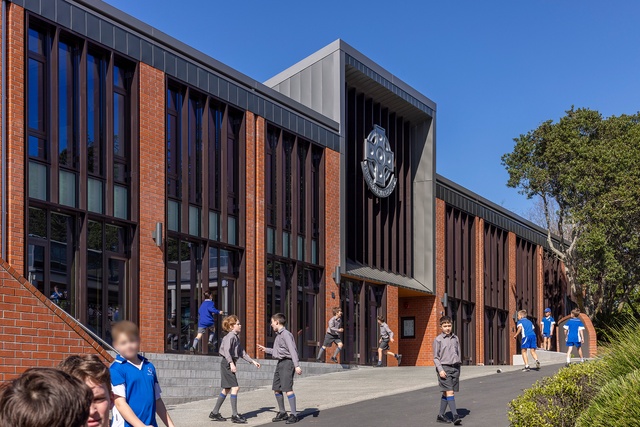
In dramatic fashion, this new component of a comprehensive masterplan frames the edge of playing fields on one side, while forming a finer grain edge to an internal lane on the other. Robust in appearance and materiality, this building is a recollection of tradition, formality and consistency. The rigour exercised in the modulation of the external envelope is also present in the diagram and consequent planning solutions that allow for the efficient circulation of users across the course of the day. This building projects an identity of confidence, stability and academic intent while taking its place within the wider school complex.
Whangārei Boys’ High School by ASC Architects
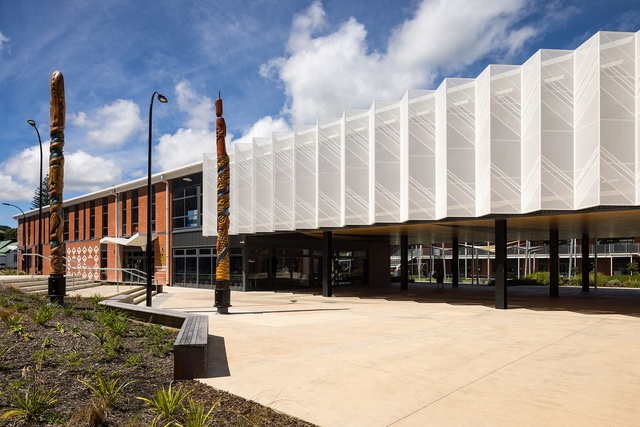
The identity and mana of Whangārei Boys High School is evident on arrival with a dramatic collection of carved pou leading to a spacious entry and ātea. Formed on a simple diagram, the campus conceals complex layers of learning, academic engagement and community ideals. The internal courtyard is a vibrant hub of activity framed by a range of learning spaces to its edge that carefully balance small and more focussed spaces with collective environments that provide for a variety of learning modes. The design provides a robust and enduring environment in which careful attention to detail speaks of respect and quality.
New Shoots Ramarama ECEC by Copeland Associates Architects
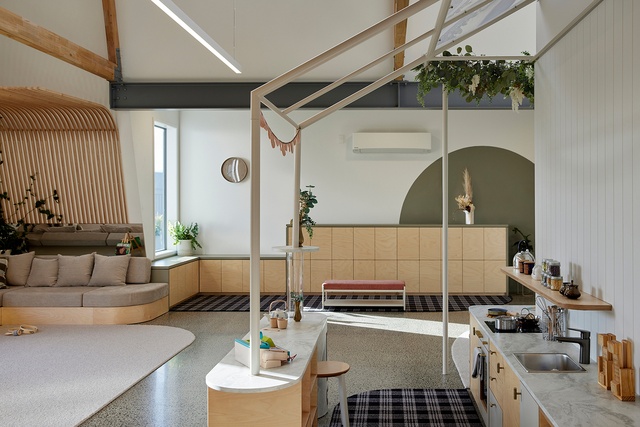
From the entrance and light-filled circulation spaces to the learning and play areas, and the exterior beyond, simple design solutions consider learning from the point of view of children and how they navigate their environment. Specialist interiors by New Shoots include child-friendly versions of adult living areas to acquaint children with learning for the home environment. While modest and unassuming, this early learning childcare centre provides an essential community facility for a new housing development at the city’s southern edge.
Owairoa Primary School by RTA Studio

The bold and playful exterior contains a calm and responsive learning environment, which clearly talks to the architect’s command of achieving balance across complex briefing requirements.
Highly legible and straightforward planning strategies deliver a variety of learning spaces through a mix of focused, enclosed and communal environments. Skilled management of brief, budget and project execution results in a highly sustainable building that generates enough renewable energy to power the building and give back to the grid. Carefully navigating the specific needs of the Ministry of Education, the school, their whānau and wider community, this project talks to the value of strong collaborative client relationships.
Heritage
The Hayman Kronfeld Building by Peddlethorp
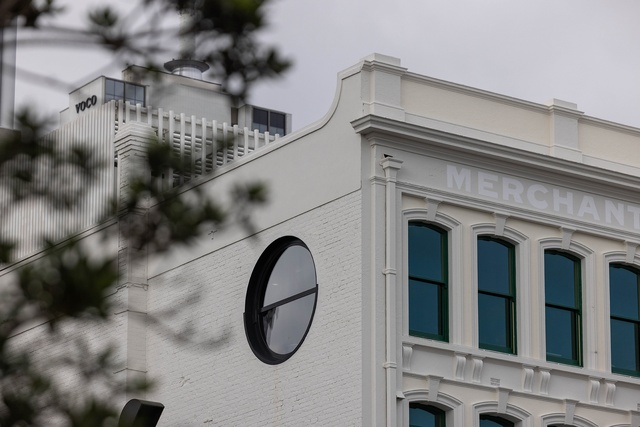
This tour de force of heritage restoration continues the regeneration of the Britomart precinct on Auckland’s waterfront and reminds us that our limited architectural heritage must be retained and celebrated. The project combines serious consideration of the existing building structure and envelope with a casual and relaxed design attitude, skilfully deployed across numerous spatial and material combinations that delight and surprise. The sustainability aspirations for the project are to be applauded — they speak to a committed client-architect relationship, one based on mutual trust and camaraderie. Engagement with the street has been carefully handled and compliments the external finishing of the two heritage façades, ensuring it will engage with the city for decades to come.
Resene Colour Award
Original materials and building fabric are exposed, returned to their natural state, and celebrated in combination with dark colour tones in applied finishes, structural elements and building services. The resulting depth, texture and recessive appearance to the interior spaces generate numerous moments of surprise and delight.
Administrator House by Rogan Nash Architects
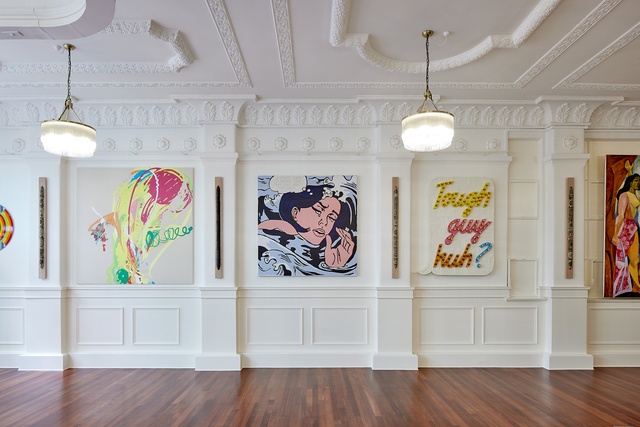
A sympathetic renovation and restoration of a 1925 building delivers a modernised gallery and commercial office space that integrates with existing heritage features. Numerous complexities, including previously completed earthquake strengthening, have been overcome with innovative design solutions that serve the building’s new purpose, while restoring original character. Limited interventions through the entry hall and office spaces modernise the building, with materials and fittings referencing the building’s original era. This project celebrates the heritage of an important inner city building and delivers a high-quality, light-filled venue.
Symonds Street Public Conveniences & Shelter by Salmond Reed Architects
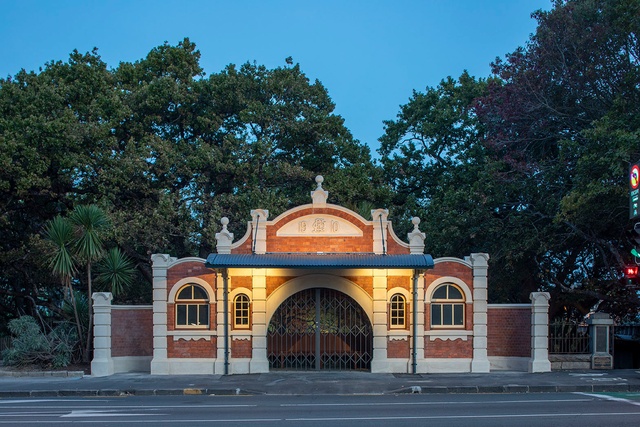
For more than 100 years, this small but iconic Auckland landmark has provided a public convenience. In more recent times, it has been used for a range of less-than-desirable activities — all the while withstanding the constant abuse of graffiti, vandalism and fires. As a scheduled Category B heritage place, the building was deserving of this faithful restoration to its former glory. Along with seismic upgrades, the work uncovered and restored much of the original interior finishing and materiality and will hopefully instil newfound respect and care from those who use the facilities.
Hospitality
Origine by Jack McKinney Architects

This project reimagines an existing restaurant with an innovative and refreshing take on what urban eateries can be in Auckland. Referencing Pierre Chareau’s Maison de Verre, the architect has carefully combined a variety of existing and new components, material finishes, colours and furniture. Glass-brick panels and screens generate a dynamic experience across two levels to the rear of a dramatic double height volume while facilitating more efficient circulation for patrons, staff and the delivery of service. The transformation of the former restaurant is superb and adds another high-profile dining destination to Auckland’s waterfront.
Enduring Architecture
Domain Wintergardens (1928) by Gummer & Ford

An iconic destination in Pukekawa, the Auckland Domain’s Wintergardens have been a central attraction for visitors and residents for more than 100 years. The Temperate House to the north-east, designed by William Gummer, was built to commemorate the Auckland Industrial Agricultural and Mining Exhibition of 1913-1914, and opened on 1st December 1913. The Tropical House, designed by the expanded practice of Gummer & Ford, was added in 1928, along with the central courtyard areas. More recently, structural strengthening and a faithful restoration of the two buildings has ensured this important part of the city’s architectural heritage will endure for many decades to come.



